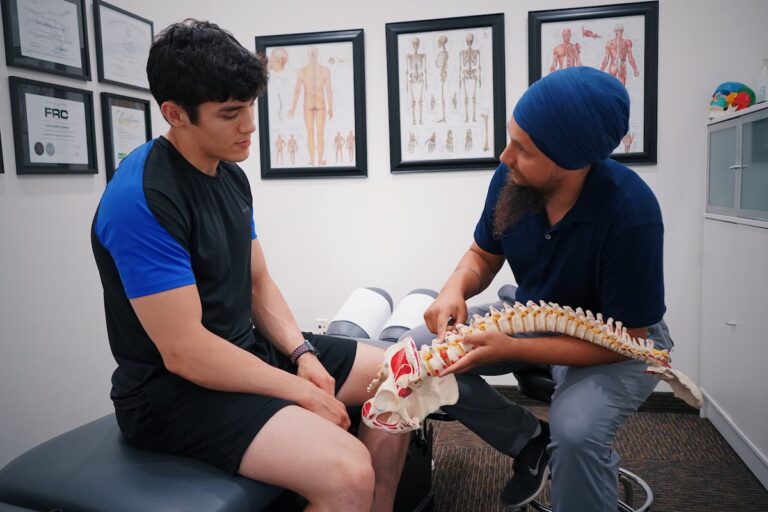Chiropractic adjustments, done right, aid in discomfort relief and boost body functionality. However, incorrect adjustments may cause adverse symptoms. These include severe headaches, unusual muscle pain, heightened joint pain, and neurological distress symptoms like numbness or tingling. Recognizing these symptoms quickly and seeking healthcare professional advice is vital to avoid further complications. The key challenge lies in discerning between regular post-adjustment discomfort and signs of a poor chiropractic adjustment. This issue merits further investigation.
Understanding Chiropractic Adjustments
Chiropractic adjustments, a manual therapy, involve trained chiropractors applying controlled force to misaligned or immobile spinal joints. These adjustments aim to enhance the body’s structural integrity and physical function. Key benefits include relief from back pain, increased mobility, improved immune response, and overall wellness, achieved through the restoration of spinal mobility. This, in turn, reduces spinal nerve inflammation and irritation.
The frequency of adjustments depends on the patient’s condition and health objectives, varying from multiple weekly visits to less frequent appointments over extended periods. Tailored to each patient, treatment plans consider factors such as age, health status, and the nature and severity of the spinal issue.
Licensed, trained professionals must conduct chiropractic adjustments to minimize potential risks and complications. Comprehending chiropractic adjustment dynamics is essential to maximize benefits and limit adverse effects. Understanding why professional chiropractic care is essential helps in recognizing the importance of seeking qualified practitioners who can ensure the safety and effectiveness of your treatments.
Importance of Proper Techniques
Proper chiropractic techniques’ importance is paramount. Incorrect methods negate health benefits and pose risks, ranging from discomfort to severe damage. Identifying improper practices is vital for patient safety and treatment effectiveness.
Risks of Incorrect Adjustments
Improper chiropractic adjustments pose significant risks, including escalated pain, spinal cord damage, neurological issues, and in rare instances, stroke. This results from neglecting proper techniques, elevating Chiropractic Malpractice risks and undermining Professional Accountability. To prevent such harm, Chiropractors must strictly adhere to professional standards and techniques.
Identifying Unprofessional Practices
Identifying unprofessional chiropractic practices is crucial for patient safety. Key elements include ethical conduct, appropriate techniques, and personalized care. Unprofessional behavior can manifest as over-treatment, use of unsuitable methods, or a lack of individual attention. Practitioners may overlook specific patient needs, leading to complications or no health improvement. Poor communication, insufficient procedure explanation, and non-disclosure of risks and alternatives can signal unprofessionalism. This highlights the need for vigilance in recognizing malpractices.
Symptom 1: Severe Headaches
Severe headaches post-chiropractic treatment suggest improper execution, possibly due to misaligned cervical spine. This misalignment can cause tension and pressure changes, leading to headaches or migraines. Migraine triggers include stress, inadequate sleep, dietary factors, and poor chiropractic adjustments. The effectiveness of headache treatments depends on the cause. Consultation with a healthcare professional is crucial for accurate diagnosis and treatment. Severe headache symptoms include heightened light or sound sensitivity, nausea, vomiting, intense throbbing, and daily task performance difficulties due to discomfort.
Symptom 2: Unusual Muscle Pain
Muscle pain post-chiropractic adjustment, potentially due to a poorly performed procedure, can cause muscle strain or inflammation. This pain, which can be dull or sharp, may stem from improper spinal joint manipulation, leading to undue muscle stress. Persistent or worsening muscle pain warrants immediate attention. Monitoring the pain’s duration, intensity, and frequency is crucial. Continued discomfort requires consultation with a healthcare professional who may recommend imaging tests to identify underlying issues like herniated disc or nerve impingement.
Pain management varies based on pain severity and individual health. Non-pharmaceutical interventions include heat or cold therapy, massage, or gentle stretching. Over-the-counter pain relievers may be used. For severe cases, stronger medication may be prescribed, or referral for physical therapy or specialized treatments may be necessary.
Symptom 3: Increased Joint Pain
Increased joint pain is a potential symptom of a poorly conducted chiropractic adjustment. This symptom, contrary to the therapeutic goals of chiropractic care, can result in amplified pain and restricted movement. It may present as:
- Heightened intensity of existing joint pain.
- New pain in previously pain-free joints.
- Prolonged or frequent episodes of joint discomfort.
- Difficulty executing regular tasks due to severe joint pain.
The correlation between increased joint pain post-chiropractic adjustment and the quality of the adjustment underlines the need for expert, personalized chiropractic services. If joint pain worsens following an adjustment, it suggests the procedure may have been improperly executed. Immediate consultation with a healthcare provider is recommended in such scenarios.
Symptom 4: Tingling or Numbness
After a chiropractic adjustment, tingling or numbness may be experienced by patients. This symptom signifies potential nerve interference or damage from incorrect manipulation and requires immediate investigation. Numbness or tingling is often a result of nerves being improperly pressured, leading to irritation or pinching. These sensations may not be instant, but develop over hours or even days, primarily affecting hands, feet, and other body areas.
Nerve Damage Prevention is crucial in chiropractic practice, relying on accurate technique and comprehensive knowledge of human anatomy. Persistent numbness or tingling after adjustment necessitates immediate consultation with a health professional. Early problem detection allows for prompt intervention and potential avoidance of further nerve damage.
Symptom 5: Dizziness or Vertigo
Dizziness or vertigo may occur post-chiropractic adjustment, indicating a potential adjustment issue. Key words defining this experience include room spinning and off-balance feelings. Understanding and managing these potential symptoms are essential.
Understanding Dizziness Post-Adjustment
Post-chiropractic adjustment, patients may experience dizziness or vertigo, which are symptoms that require further analysis. Dizziness may stem from spinal misalignments affecting the nervous system and inner ear, while vertigo typically indicates a sensation of spinning, treated by addressing the root cause. Symptoms include a sensation of imbalance, a stationary whirlwind feeling, unexplained faintness, and confusion. It is crucial to report these symptoms to your chiropractor immediately for prompt, effective care, preventing complications, and enhancing overall health.
Vertigo: A Potential Symptom
A potential aftereffect of an improperly conducted chiropractic adjustment can be vertigo, defined by sensations of spinning or balance loss. This temporary yet disorienting condition can escalate to debilitating levels. Treatment for vertigo varies based on cause and severity, ranging from vestibular rehabilitation therapy to medication, and in rare scenarios, surgery. It’s vital to ascertain whether vertigo is directly linked to the chiropractic adjustment or an underlying health issue. The psychological impact of vertigo, such as anxiety or panic attacks due to fear of loss of control or falling, can be substantial. Therefore, precise and timely management of vertigo is key to reduce its physical and psychological effects.
Managing Adjustment-Induced Dizziness
To manage dizziness post chiropractic adjustment, employ strategies such as hydration, rest, balanced diet, and adjustment frequency reduction.
Hydration can counter dizziness caused by dehydration. Rest allows recovery post-adjustment. Balanced, nutritious meals stabilize blood sugar, thus reducing dizziness. Discussing adjustment frequency with your chiropractor may help manage symptoms.
Symptom 6: Loss of Strength
After a chiropractic adjustment, loss of strength may occur. This can impact daily functionality, measured through techniques like manual muscle testing, dynamometry, and functional tasks. Nutrition plays a crucial role in maintaining muscle strength; deficiencies in protein, vitamin D, and omega-3 fatty acids may amplify strength loss post-adjustment. The loss of strength can result from nerve damage, improper correction of misalignment, or serious complications like a stroke. Immediate reporting to a healthcare provider is vital for proper evaluation and intervention. A balanced diet ensures adequate intake of essential muscle-strengthening nutrients.
Symptom 7: Difficulty Sleeping
“Symptom 7: Difficulty Sleeping” pertains to potential issues post-chiropractic adjustment. Disrupted sleep could result from improper manipulation, possibly inducing insomnia. Evaluating this symptom aids in assessing adjustment effectiveness and identifying the need for corrective actions. To better understand and manage these types of side effects, consider exploring resources on Managing Chiropractic Treatment Side Effects, which provide insights into handling various treatment responses and promoting recovery.
Sleep Disruption Causes
What causes sleep disruption after a bad chiropractic adjustment? Several factors contribute: spinal misalignment causing discomfort, anxiety from a negative experience, nervous system adverse effects, and circadian rhythm disruption due to physiological changes. These factors disturb sleep hygiene, impacting regular sleep schedules and the tranquility of the sleep environment, leading to restless nights. Seek professional assistance if sleep disruption occurs post-adjustment, indicating a potentially suboptimal procedure.
Adjustment and Insomnia
Insomnia, or continuous sleep disruption, can result from an improper chiropractic adjustment. If the adjustment incorrectly manipulates muscles, it can cause discomfort or pain disrupting sleep, consequently triggering insomnia. The situation can worsen if the adjustment exacerbates existing conditions or introduces new stressors. The anxiety or stress from a sub-optimal adjustment can also induce insomnia. Maintaining a consistent sleep schedule and creating a calm environment can alleviate these effects. Persistent insomnia might imply a need to reassess the chiropractic treatment, suggesting the possibility of a previous improper adjustment.
Symptom 8: Recurring Stiffness
Recurring stiffness can signify incorrect chiropractic adjustment. The stiffness roots from multiple causes such as overcorrection, incomplete adjustment, ignored underlying health issues, or delayed body response post-adjustment. Discovering the cause paves the way for treatments like additional adjustments, physical therapy, or alternative therapies like acupuncture or massage. Promptly reporting recurring stiffness to a chiropractor is vital for reassessment or treatment modification, ensuring effective stiffness management, and overall health improvement.
When to Consult a Doctor
Consult a doctor post-chiropractic adjustment if experiencing symptoms like severe pain, persistent discomfort, numbness, weakness, or coordination loss. A physician’s expertise is crucial for diagnosing and treating potential complications or aggravated health conditions. They offer valuable insight into symptom nature and suggest treatment alternatives like medication, physical therapy, or other non-invasive therapies. Persistent symptoms may necessitate further diagnostic tests like MRI or CT scans. Chiropractic adjustments, though generally safe, must be performed by trained professionals. Don’t dismiss post-adjustment symptoms as normal; seek medical advice when needed. Ensuring your healthcare provider’s qualifications and understanding treatment alternatives is vital for well-being.
Preventive Measures for Future Adjustments
To optimize chiropractic care benefits and minimize risks, preventive measures are essential. These can include lifestyle changes and post-adjustment exercises.
Key strategies include:
- Chiropractic Alternatives Exploration: Integrating therapies like massage, acupuncture, or osteopathy can foster comprehensive musculoskeletal health.
- Post-Adjustment Exercises: Chiropractor-recommended exercises can sustain adjustment gains and avert future discomfort.
- Hydration Maintenance: Adequate water intake can curb inflammation, expedite muscle recovery, and aid post-adjustment healing.
- Chiropractor Communication: Sharing concerns or adverse symptoms with your chiropractor can refine their technique or treatment plan.
Frequently Asked Questions
What Qualifications Should a Good Chiropractor Possess?
A qualified chiropractor holds a Doctor of Chiropractic degree, meets rigorous licensing criteria, and shows consistent professional growth. Essential skills include anatomy knowledge, effective communication, and a patient-focused approach.
Are There Potential Side Effects for First-Time Chiropractic Patients?
First-time chiropractic patients may experience adjustment reactions, including headaches, fatigue, or body discomfort. Awareness of these potential side effects is crucial for a positive chiropractic experience.
Can Chiropractic Adjustments Cause Digestive Issues?
Chiropractic adjustments can potentially impact digestive functionality, depending on individual health, specific adjustment technique, and nutritional habits pre and post adjustment.
How Often Should One Get a Chiropractic Adjustment?
Chiropractic adjustment frequency depends on individual health conditions and recovery progress, determined through regular chiropractor consultations.
Are There Alternatives to Chiropractic Adjustments for Pain Management?
Indeed, acupuncture and yoga therapy serve as effective alternatives to chiropractic adjustments for pain management. Acupuncture, known for its efficacy in pain relief, and yoga therapy, recognized for enhancing flexibility, strength, and body alignment, provide viable options in treating pain.






